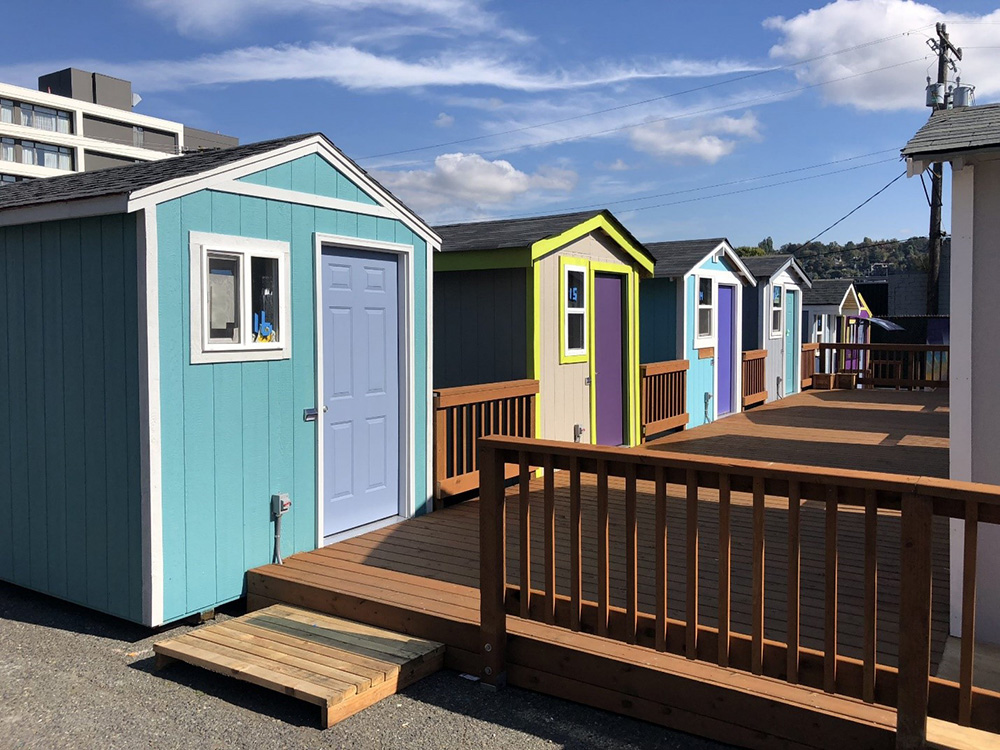The decision by Vancouver’s council on Oct. 15 might have seemed like a victory for every homeless person in the city who yearns to escape the streets or their damp tents for a warm, dry, secure home of their own.
After all, council unanimously passed a directive ordering staff to adjust city building codes to allow for the construction of tiny homes for those in need. This special member motion was submitted by Coun. Pete Fry, who has been focused on finding immediate solutions to the growing homeless encampment at Strathcona Park.
He and other residents of the Strathcona neighbourhood are justifiably concerned about a public health emergency in that neighbourhood, an unsupported encampment of, by some estimates, over 300 people.
With winter setting in and a resurgence of COVID-19
And that is the beauty of the tiny homes temporary approach to Vancouver’s housing crisis. If the city, non-profits or private interests can identify land available for the next year, communities of tiny homes could be inexpensively built within a month or two — before the worst of winter hits.
Unfortunately, the final motion passed by council doesn’t reflect such urgency.
Coun. Lisa Dominato, trying to speed things along, offered an amendment to Fry’s motion, which hadn’t included a date for completion. Her amendment called for “a Tiny Home Village demonstration project this winter.”
During floor debate on Dominato’s amendment, Mayor Kennedy Stewart asked city manager Sadhu Johnston if this was possible:
“How I am reading this is that you would direct staff to drop a lot of work that you are doing immediately.... Do you have any idea of how much this would cost, and would you need direction from council to direct staff to set up something they had never done before? Would you need a direction from council to spend city funds on this if you were to proceed? And thirdly, what work would you have to drop to make this happen immediately?”
As if on cue, Johnston said, “I do not think this is viable” for this winter. He listed logistical complexities, such as letting and managing contracts, arranging for sewer and water, permit issues, sites procurement, zoning issue, and “many, many other things” as a list of the barriers in the way of building a tiny homes village this winter.
Staff are just too busy, he stated. To help along a tiny homes community or two, “we would have to stop work on the motion that was approved last week.” Here Sadhu was referring to the $30 million allocated to buy or lease additional hotel rooms for homeless people.
Coun. Dominato, supported by fellow councillors Colleen Hardwick, Sarah Kirby-Yung and Melissa De Genova, pushed back. They argued the cost of tiny homes was much less than hotels, and that both citizens and churches are anxious to help.
Dominato went on to say that since the city was able to establish outdoor café seating in what were former bus lanes due to COVID-19, it was hard for her to understand why the city could not respond at a similar speed to find land and accommodation in the face of this crisis.
But the persistent message on the other side was that staff was preoccupied with other priorities.
As the hedging continued, Coun. Fry, possibly sensing danger to the original motion, offered a new amendment. He suggested removing this winter as a date of execution, issuing the softer instruction that staff report back “as soon as possible.”
And there you have it. That is how human priorities are rationed by government.
Council to its credit eventually voted unanimously to advance the tiny homes concept, but in doing so made it seem very unlikely that this solution would be in place before the chilling rains arrive and the much-feared second wave of COVID-19 sweeps through our community.
This winter it seems we are left with tent cities per usual, as if there is no alternative.
Wait. What about those single-room occupancy hotel units? It is laudable that the council allocated $30 million for securing hotel space for the homeless. But even that large sum is not likely to accomplish much. The purchase of the 63-room Buchan Hotel for supportive housing for women cost the province $19.4 million. That’s $308,000 per room. Viewed in this light, $30 million will not go far.
Tiny homes, by contrast, cost about $10,000 each and therefore could house 100 people for only $1 million. They aren’t a long-term solution to homelessness and should never be presented as such. But as a fast response in an emergency, they are a huge step up from living in tents or on the streets.
As made clear by three councillors supporting the tiny homes approach — Dominato, Hardwick and Fry — tiny home villages, scattered and largely self-managed, have been shown to provide a more supportive social grouping than even modular homes. If properly curated, they offer more stability and security than our SRO settings.
Furthermore, the tiny homes option lets the community play a role in supporting our fellow citizens, by offering church parking lots or backyard space to those in need.
In supporting the tiny homes concept, Coun. Hardwick pointed out that we are facing a moment similar to when soldiers returned from the Second World War and had no place to stay. As she noted, Vancouver’s leaders then changed ordinances quickly to legalize rooming houses for veterans. Not perfect, but better than homelessness.
Here we are in 2020, a much richer city benefiting from our status as a magnet for global wealth. Can we show the world we can innovate on behalf of our poorest citizens as well?
Why not set a hard deadline? Why not tiny home communities built by Christmas? And why not encourage citizens, civil society and church groups to work with the city to get this done?
With flexibility accorded by city hall, it can be done, experts such as Bryn Davidson and Scot Hein have assured city staff. Getting folks under roofs and behind lockable doors fast is not only possible, it is imperative. Winter is almost here. Where’s the sense of urgency? ![]()
Read more: Housing, Municipal Politics
















Tyee Commenting Guidelines
Comments that violate guidelines risk being deleted, and violations may result in a temporary or permanent user ban. Maintain the spirit of good conversation to stay in the discussion.
*Please note The Tyee is not a forum for spreading misinformation about COVID-19, denying its existence or minimizing its risk to public health.
Do:
Do not: